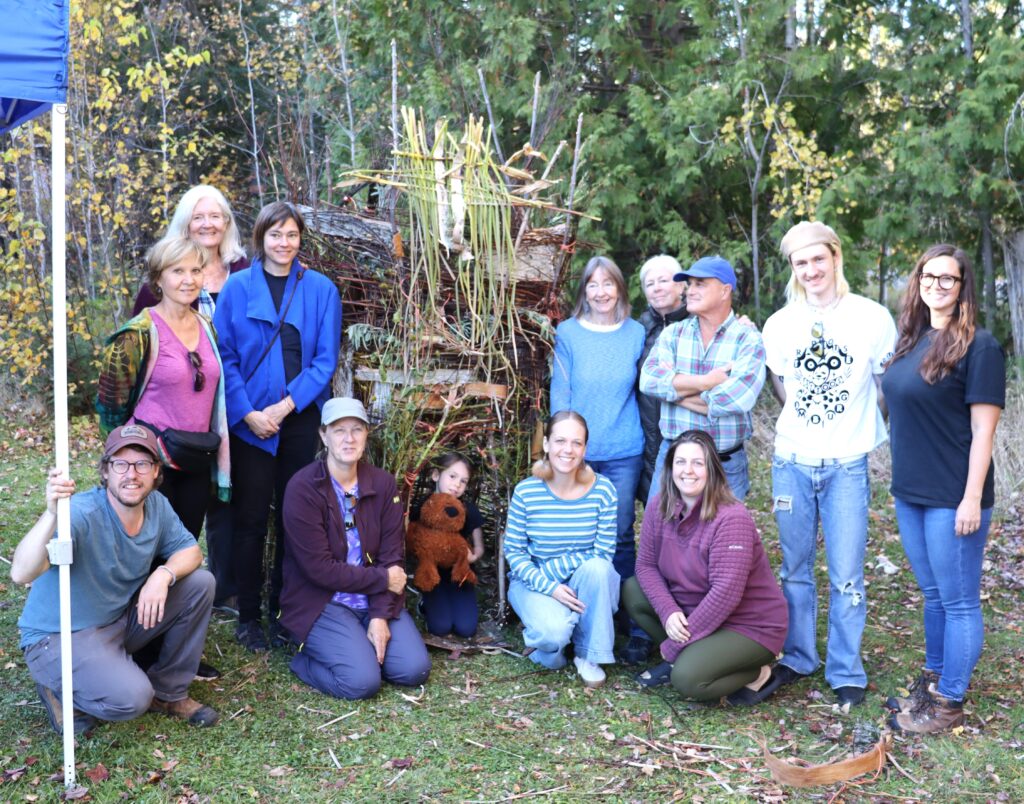Art Helps builds more than natural structures

By Michael Riley
Local Journalism Initiative Reporter
The Art Helps: Connecting with Natural Materials-Plants, built more than a natural structure on Oct. 19 on the north lawn at Camp Bongopix in Whitney. It built comradery, sharing knowledge and artistic vision and friendships. The event was sponsored by Ottawa Valley Community Arts (www.ottawavalleycommunityarts.ca), hosted by Camp Bongopix (www.bongopix.com), and facilitated by Christine Luckasavitch (waaseyaaculturaltours.com), and artist Megan Spencer (www.meganspencer.ca), who showed attendees about plant and animal relationships, weaving techniques and collaboratively creating a temporary natural installation.
Anya Gansterer, co-artistic director with the Ottawa Valley Community Arts told Bancroft This Week on Oct. 10 that the event is part of a project funded via the Ontario Trillium Foundation called ART Helps: Exploring Natural Materials and is active from April, 2024 to August, 2025.
“[It] includes monthly workshops to support community wellbeing through making art together and spending time outside working with natural materials. We are offering the workshops in different locations around the Ottawa Valley. This collaboration with Camp Bongopix is the sixth workshop in the series,” she said.
Andy Trull, co-artistic director with OVCA, told Bancroft This Week that the goal of the workshop series is to bring people together to make art and to improve our general mental health coming out of troubling times like the COVID-19 pandemic.
“So it's all about coming together, trying to be outdoors as much as we can, working with natural materials and then people come with whatever knowledge and experience they have to work with the artist/facilitators and just have a good time,” he says.
Spencer says that Gansterer reached out to her and Luckasavitch and she thought she seeded the concept.
“And with that idea, that we would make something working with plants and building something with them. All the materials were gathered by Christine and I and brought here today. It was easier to gather them beforehand and bring them here,” she says.
Luckasavitch says that they were pretty mindful that the plant materials were non-invasive and making sure they weren't brining in undesirable seeds.
“We were pretty careful about that. We set out the form [of the natural structure] and collaboratively we'll see what shape it actually takes. We also took some inspiration from land artists we admire like Andy Goldsworthy. So, we'll be tying it in with all the land-based knowledge coming from folks who work a lot on the land,” she says.
Some of the materials used that day on the natural structure were willow branches, tomato stalks, stalks of Indigenous strains of corn, cat tails, beaver sticks, cooking sage, lemongrass, twine from hay, and birch bark (left over from a birch bark canoe build made a couple of years ago).
Jenn and her daughter Zoë were working on the natural structure and Jenn said she'd seen that this workshop was available and was free.
“I've come across a lot of workshops and this one it was like, yeah, let's go. So, we planned it out and here we go,” she says.
Shauna Siydock said it was her love of plants that got her to participate.
“As soon as I see anything to do with plants and gardening, I'm absolutely there. Christine has shared her gardening knowledge with me previously and I got some tips for my own garden from her. It's great to learn with the community,” she says.
Petra says she likes any work using her hands.
“I love working with anything in nature and I love weaving. I'm new to it but I love it,” she says.
After the build was finished, everyone did a closing circle, where they all discussed what the workshop was like for everyone and what they learned from it. Luckasavitch told them that they had to listen to what the plant materials were telling them to do.
“That's not something we do in our everyday. We don't take a minute to listen to all these beings that we're surrounded by. Whereas here we are. We've spent the last three hours or so together and how great do you feel being in community, hanging out with these relatives as well as each other. Give yourself that time in your day to day to listen, to exist, to collaborate. You need to make that time for yourself. Go hug a tree, go hang out and talk to the trees in your yard, go spend time by the water. Do whatever it is to give yourself a moment to listen. I don't know if we listen enough,” she says.
Spencer told Bancroft This Week that it's always interesting to see how the workshops go.
“It's a good sign when people stick around. It's always interesting to know where people are at and what they're bringing to it. To have people feel comfortable participating and collaborating and bringing what they have to the experience. It's just nice to do something that's outside of our regular way of doing things. It's fun, it's just kind of suspending reality and a lot of these moments you're pulling yourself out of the day to day and entering a different space and way of approaching something. I feel that art making, moving into that space for anyone opens up so much more in their day to day lives,” she says. “There's a lot of different ways that art making contributes to our sense of openness and well-being.”
|
